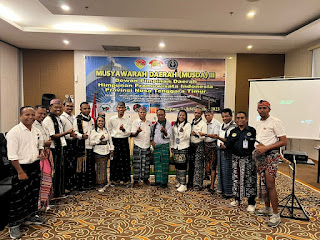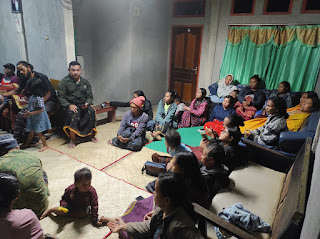Conference Trip to Timor; More Than Just A Trip For Work, Giving Unexpected Bonuses.
It has been a while since the last time I shared my travel stories in this blog. The story to Todo village with Indonesian travelers in January 2022 was the last time I could put marks on this platform, if you wonder why, it is simply because my visit to Timor has come beyond my expectations.
Traveling to
Timor is not my first time, some of my friends thought it was my first time to
Timor, even a close friend of mine, Maria from Poland who has been to Flores
three times worried if it would be my first time to get on the plane, away from
Ruteng. None said it right. I have been to Kupang in 2010 or 13 years ago when
I was at the last year of my high school at SMK Sadar Wisata Ruteng for guiding
contest towards all vocational high school students in East Nusa Tenggara
Province.
Maria’s
worrying about me getting on the plane made sense. Even though it was not my
first time but I could still count how many and nothing really changed me on
how exciting to see the world from the sky but on contrary, the worst part is
always on take-off and landing experience. It is just horrible. I felt like my
breath was taken out completely. This got me wanting not to fly again hence, I
tried to convince myself that apart from other means of transport, plane is
considered as the safest vehicle to use.
My trip to
Kupang was actually for a work that I was delegated by DPC HPI Manggarai (Dewan Pimpinan Cabang Himpunan Pramuwisata Indonesia) or so called
Regency Board
of Indonesian Tourist Guide Association that hosted by Provincial Board or DPD (Dewan Pimpinan Daerah) located in Kupang as the
capital of East Nusa Tenggara Province. However, this trip has drawn me to get to
know some nice places in and around Kupang that I could really admire. Those
places will be mentioned below after I introduce you what our association is
all about.
The
Indonesian Tourist Guide Association was established at the first National
Conference in 1988 in Palembang as a single conference recognized by the
government for individuals who have a profession as tour guides. National Board
of HPI so called DPP (Dewan Pimpinan Pusat), Provincial Board is DPD (Dewan
Pimpinan Daerah) and Regency Board for (Dewan Pimpinan Cabang). DPP HPI currently coordinates 34 provincial
capitals, and has been established in 189 regencies in Indonesia with The
number of registered members in the National HPI database is 12,279 people. The
number of HPI DPC in East Nusa Tenggara Province is 15 DPC with 630 members
(data shared by DPD HPI NTT).
 |
| The delegations from 9 DPC in East Nusa Tenggara Province |
HPI
functions as a forum for tourist guides Indonesia in order to communicate and
collaborate between tour guides, tour guide with the government, and other
tourism associations in order to develop the tourism industry. HPI is a nonprofit,
non-political association which groups together, based on the individuals’
interest and awareness as said on its mars that tour guide is a spearhead of
tourism and a frontliner to show the beauty of Indonesia to entire world.
As for the
conference in Kupang was intended to carry out every 5 years to vote for a new
head of DPD, it has successfully won by Victor Pance, S.Pd who is a member of
DPC HPI Manggarai Barat, west part of Flores. He is expected to lead for 5
years in the period of 2023-2028 after competing with the other Mr. Martinus
Klau, S.Pd from Kupang and Mr. Agustinus Bataona, S.Fil from Maumere who is
former head of DPD.
The
conference was the main highlight of the trip but seeing something special from
the capital is worth to add the value of the journey.
Baun Se’i Babi
 |
When we talk about Se’i, it almost refers to pork in East
Nusa Tenggara. But actually Se’i or
to smoke meat is not only for pork but also for any other meats like I have
seen in the restaurant in Labuan Bajo that provides on their menu se’i sapi
for a smoked beef. However, se’i in
East Nusa Tenggara Province means se’i babi
or smoked pork that was originally introduced in Timor Island. Since se’i babi is my favourite meat, I cannot
put myself aside when the committee proposed us to see something around Kupang
before the conference was started.
One of the famous places and mentioned as the origin place of se’i babi is so called Baun, 28 km from Kupang or about an hour drive by car. In Baun, there is a man who invented se’i babi named Bai or well-known as Om Bai. Even though we could not meet him personally but his creatures were easily seen and tasted as we in a big group divided into 2 cars in a total of 16 people as member of conference could travel through time to get to know when se’i babi was firstly made and how the pork is processed till it is so called se’i babi.
Gina, a lady
who works for Om Bai explained that Se’i
babi was started in 1997 by Om Bai who was selling pork on the street
carrying on his shoulder until one day he failed to find buyers and he decided
to do se’i or a canning which is a process
of food preservation through smoking. Since then, many liked Om Bai’s creations
and it became so popular not only in Kupang but the whole province of East Nusa
Tenggara that he finally opened a restaurant in his house called Se’i Babi Baun
Om Bai.
Agus Bataona
who is one of the elders in HPI explained more about how se’i babi is processed which is basically the pork is sliced is
small pieces and then to be smoked on a high heat by using kesambi wood together with its leaves, Schleichera oleosa (latin) or gum-lac
tree (in English) for firing. “This smoking
process was used as a canning method on pork”, he added.
He cannot deny
the fact that Baun historically was a center of where se’i babi was
originally being made for the first time until it became so popular in East
Nusa Tenggara Province.
Rumah
Sasando
After seeing and tasting se’i babi directly on its birthplace, me
and the group whose members are representative from 9 DPC HPI traveled back to Kupang to enjoy the
atmosphere of the main provincial capital. One place we stopped by was Kantor
Gubernur or Governor’s main office which architecture looks like sasando or a traditional musical
instrument origin to Rote that has been so well-known not only in Indonesia but
all around the world.
 |
| John Pah playing sasandu with “Ti’ilangga” on his head |
“For those
who play sasandu, they must wear “Ti’ilangga” or traditional hat as the main
outfit when playing this unique musical instrument” he added.
If Kupang was supposed to be just for work, I can’t thank enough to the committee for showing us more of the area that surely add the value of my second visit to Timor. The journey was unplanned but had come beyond my expectations.





Komentar